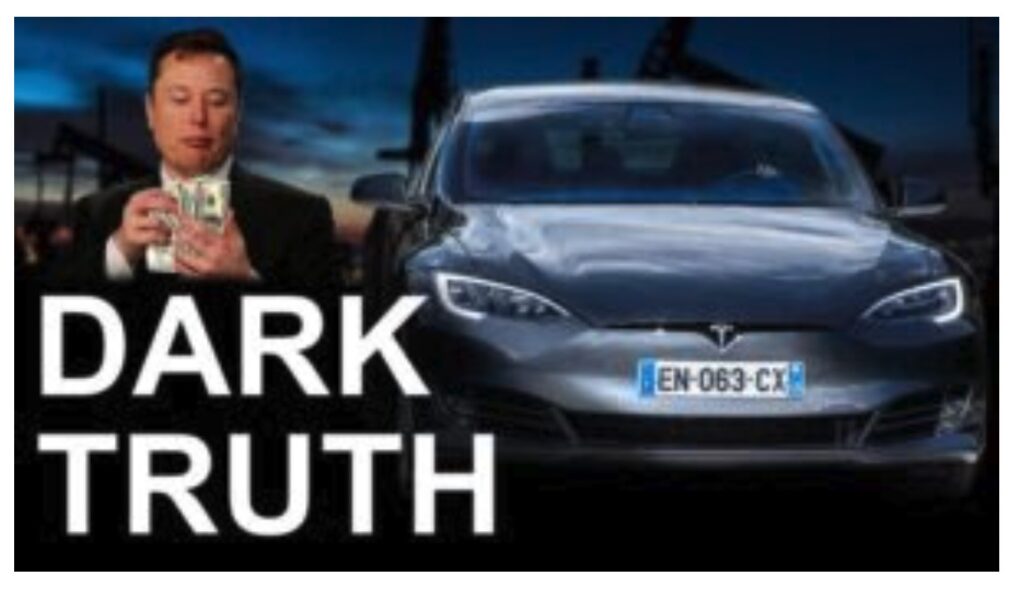BeforeItsNews.com
Everyone knows – well, everyone has heard – that EeeeeeeeeeeVeeeeeeeeeee are the vehicles for solving what is said to be the “climate crisis” – which is an interesting thing to say, given the EeeeeeeeeeeVeeeeeeeees being produced are much more powerful than they need to be to get people from A to B. That requires huge batteries, to store all the electricity needed to make them go very fast, very quickly.
You’d think that would be discouraged – even banned – if there is a “crisis” looming that is being caused by the “emission” of carbon dioxide. After all, more of the latter is being “emitted” than necessary by the utility plants that generate almost all of the electricity that powers over-powered EeeeeeeeeeeVeeeeeeees.
Does anyone need to get 60 in 2.9 seconds? Or even six? If there is a “crisis,” that is. Yet practically every EeeeeeeVeeeeee on the market is designed specifically to use up more power than is needed for bare minimum or even economy-car-equivalent basic transportation needs.
This tells you something about the true nature of the “crisis” – and those who say it is one. If a ship on the open sea has sprung a leak and is sinking, do you open more holes below the waterline?
There are some other things about EeeeeeeeeeeeVeeeeeeeees they aren’t telling you about as well.

You can’t “fast” charge an EeeeeeeeeVeeeeee at home –
Practically every article gushing about EeeeeeeVeeeeeees will report on the fact that it is possible to “fast”charge an EeeeeeeeeeeVeeee in about 30 minutes. Some will gushingly report that – soon! – you’ll be able to do it in less than 15 minutes. What they never tell you is that you cannot do this at home. Because private homes do not have the capability to “fast” charge an EeeeeeVeeeee. The very “fastest” you can charge an EeeeeeeeeeVeeee at a private home is in around eight-nine hours, on a 240 volt (dryer-type) outlet.
You will never be able to “fast” charge an EeeeeeeeeVeeeee at home. Not without completely rewiring the home to commercial-grade capacity. This means you will always have to drive to wherever the “fast” charger is – and wait there. This means spending time getting to (and from) the “fast” charger. Which means spending more time “fast” charging. Thirty minutes to “fast” charge” ends up being that plus however long it took to drive there, plus the wait there.
And that “15 minutes” – soon! – they also gush about? They do not tell you that while it might be “faster” it is less. As in, not a full recharge. Just enough to get going again. But not very far – before you’ll need to stop (and wait) again.

Speaking of which . . .
A “fast” charge is never a full charge –
Whenever you read an article gushing about EeeeeeeeeeeVeeeeees and the miracle of taking at least five times as long to “fast” charge it vs. the five minutes it takes to refuel a non-EeeeeeeeeVeeeeeeee, you will never encounter the disclaimer that the “fast” charge is only 80 percent charged. In other words, you end up with 20 percent less charge than a full charge, which means 20 percent less range . . . which means having to stop (again) 20 percent sooner.
The reason why you cannot – well, should not – “fast” charge an EeeeeeVeeeee to fully charged is because it is hard on the battery, which is the most expensive part of an EeeeeeeeeeeVeeeeee. There is also an increased fire risk. So EeeeeeeeeeeeVeeeeeees (and “fast” chargers) are set up to deliver 80 percent charge “fast” – and the rest, slow.
This 20 percent loss of charge-range – assuming you don’t have time to wait for a full (slow) charge – is probably not a huge big deal if you aren’t going far or have the time to stop and wait (again). But if you’re on a long trip, you’ll be stopping – and waiting – more than you’ve been led to believe you will be.
Speaking of that . . .
The farther you drive, the shorter the service life –
If you drive an EeeeeeeeVeeeeee to the limit of its range, you will have heavily discharged its battery pack. If you want the battery pack to last you should avoid doing this, because regularly discharging a battery is likely to reduce the life of the battery. Meaning, its capacity to hold the charge (and so, deliver the range) it advertised when new. This is why hybrid cars are designed to always keep the battery partially charged. Even so, a hybrid car’s battery pack eventually loses its capacity to hold charge and must be replaced.
But EeeeeeeeeVeeeeees have no gas engine on board to keep the battery from being heavily discharged. This presents a paradox: If you use the EeeeeeeeeVeeeeee’s advertised range you are reducing the battery pack’s service life. Put another way: The EeeeeeeeVeeeeeee’s advertised range is functionally about 30 percent less-than-advertised, if you want to avoid having to spend 30-50 percent as much as the EeeeeeeeeeeeeVeeeeee itself cost you on a replacement battery pack before it is time to replace the EeeeeeeeeeeVeeeeee, itself.
You have probably not heard about this, either. But you really ought to know about it, if you’re thinking about buying an EeeeeeeeVeeeee.
There are some other things to know about EeeeeeeeVeeeees, too.
If you don’t have a garage, where will you plug in your EeeeeeeeeeVeeeeeee? Will you be able to run an extension cord from inside your house – or apartment – to wherever the EeeeeeeeVeeeeee is parked?
Did you know that leaving an EeeeeeeeeeVeeeeeee garaged outside – in the cold – will result in the EeeeeeeeeeeVeeeeeee’s range when you parked it being less when you get up the next day to drive it? This is because EeeeeeeeeeeeeVeeeeeees burn power even when they aren’t being used – because EeeeeeeeeeeeVeeeeeees have powered heating (and cooling) systems that are always on – to keep the battery from getting too cold (or too hot). That means needing to keep the EeeeeeeeeeeVeeeeeeee plugged in, to avoid loss of charge while it’s just sitting – especially if it is sitting outside, in the cold (or heat).
Finally – for those who are considering an EeeeeeeeeeeeeVeeeeeee because they believe that they are thereby reducing their “carbon footprint”: You are probably increasing it. For two reasons.
One, EeeeeeeeeeeeeeeVeeeeeees do not last as long as non-EeeeeeeeeeVeeeeees – because EeeeeeeeeeeVeeeeeeee battery packs do not last as long as non-EeeeeeeeeeeVeeeees do and cost more than it’s worth to replace them when they can no longer power the EeeeeeeeVeeeee. That means a new EeeeeeeeeeeeVeeeeeeeeee sooner. Which means new raw materials (and carbon dioxide “emissions”) to make the new EeeeeeeeeeVeeeeee – which will be just as prematurely
disposable as the old EeeeeeeeeeVeeeeee.
Two, because EeeeeeeeeeeVeeeeeeees are energy hogs. Even the small ones like the Tesla 3 – which is a compact-sized car comparable to a Honda Civic sedan – has more than 1,000 pounds of battery pack, which it uses to deliver the speedy 0-60 times it touts. But that entails a probable doubling of the size of the battery pack that would otherwise be needed to deliver adequate (rather than “ludicrous”) speed – and also uses twice (or more) the power needed to keep it charged up. Almost all of that power – especially the commercial-grade power available at “fast” chargers – produced by combusting lots of natural gas, oil and coal. Resulting in lots of carbon dioxide “emissions.”
So, why aren’t the people hard-selling EeeeeeeeeeVeeeeeees telling people these things? Well, for the same reason the same people didn’t tell the people about the “vaccines” – until after they’d been injected with them.











I bought a cake and a roll at 7eleven the other night. The man said you can have the roll for frfee. It is 2 minutes past the use by date (and I guess time).
Climate always changes. Long before humans the temperature changes. We do not have to abandon petrol coa and gas.
https://www.youtube.com/watch?v=U_r97c_Oc6c
BillAu, you are totally correct.
Every time the government gets involved in something they know nothing about its sheer madness. Low flow toilets are a perfect example. Plumbers report that pipe clogs are an epidemic. Your ”flush” has to flow many feet to get to the big main sewer. Without water in your pipe, it does NOT flow, it stops. Good luck folks.
Our former Prius had the battery go dead a week before the expiration date and we got a new $2k battery.
I bought a cake and a roll at 7eleven the other night. The man said you can have the roll for frfee. It is 2 minutes past the use by date (and I guess time).
EeeeeVeeee’s are the nightmare cars of this Century. As I have said before, people will learn to hate them.
Did you know that ALL of the planets are heating up? This is caused by the SUN. There is little to nothing we on planet earth can do about it. This is something that the nervous Nelly Climate Changers scream about.
Attachment
Mars, Venus and ALL the other planets are heating up and they have no cars or hamburger stands on any of them. Did you know that? Trying to fight the SUN is total madness. In case you didn’t know, the SUN is a big deal in our space area.
Attachment
Forget about totally electric vehicles. It’s just another of the many ways they are attempting to destroy the USA. If you care to make yourself “environmentally responsible” (whatever the f that means), get a hybrid. Prius’ are the best. I think the price for a new one is someplace between $24K to 30K….Personally, I never buy new. You can get a used one from a dealer with some great warranties. I’ve had mine since 2008 and it had 120,000 miles on it. It’s a 2004 and I paid $11K cash in 2008. It still has the same main battery. You can pick up one on Amazon or Ebay for around $2K…..only hook is the dealer will have to install it unless you can find a shop with the right equipment. The new Prius’ come with a 100,000 mile warranty on the battery.
The Hyundai Ioniq is much better, Will. It’s a highly r ated car whose sticker price is a bit lower than the Prius and doesn’t have the current high “markup” that Priuses do–>$10K.
Not familiar with that car, so I’ll certainly take your word for it. Hyundai has always made a darn good vehicle…hybrid or not. I’ve been more than happy with the Prius I have now had for 14 years. I’m pretty sure Prius was the first (not that it matters, because most times, innovators come in last as time goes on). Initially, I think they also had a total electric that did not work out well (2003 or 2004). But now they have a new all electric that goes for around $48K….I have no idea how that’s selling….I would not expect it’s doing very well.